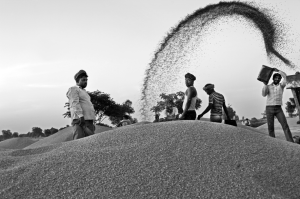Guest-Editorial: The many layers of Punjab

By Karthik Venkatesh
A millennium after it first came to be recognized as the gateway to the sub-continent, Punjab continues to remain a land in ferment. Since 1947, the state has witnessed alternate cycles of pain and prosperity. The pain of Partition was followed by the promise of the Green Revolution. This period of prosperity was followed by the dark decade of separatist violence. The relative peace that followed the ruthless suppression of this movement has now given to a four-pronged crisis revolving around less-than-remunerative agriculture, lack of employment opportunities, Dalit assertion, and women’s issues.
The essays in this special issue of Café Dissensus on Punjab attempt to delve into the many layers of Punjab. Addressing a variety of issues that have to do with the state, each essay is a fascinating insight into the many complex realities of Punjab.
Amandeep Sandhu’s essay, ‘The story of the gate is not the story of the house’ is a good starting point. It is almost entirely about a series of happenings at the border of India and Pakistan. It details a trip undertaken to the border areas of Punjab in the aftermath of the ‘surgical strike’ of September 2016. It narrates the many trials and tribulations faced by the populace in the aftermath of the army action and, in this process, it also unearths the prevalence of an earthy nationalism that is far more sincere than the obscene chest-thumping, flag-waving nationalism that is often on display in the bigger cities of the nation.
Prof. Chaman Lal’s essay on the journey of Panjab University from its origins in Lahore to its present-day avatar in Chandigarh is as much a history of an educational institution as it is a meditation on what Punjab lost due to Partition. In recounting the early days of the university, Prof. Lal is in effect recounting the halcyon days that were brought to a rude end in 1947. The prolonged period of ‘adjustment’ that the university had to undergo could well be seen as a metaphor for what the state of Punjab itself had to undergo.
Dr. Anirudh Kala’s essay entitled, ‘Punjab, the backyard of Chandigarh’ takes this discussion of ‘adjustment’ a little further. It is an exploration of an issue peculiar to Punjab and Haryana, the state carved out of Punjab in 1966. At one level, it lays bare the many problems that emerged as a result of that division. Equally, it highlights the love-hate relationship that Punjabis share with the city that was created for the people of the state to get over the twin traumas of Partition and the loss of old Punjab’s cultural and administrative capital, Lahore, to Pakistan. Chandigarh is at one level the jewel in Punjab’s crown, but equally it is an albatross round its neck. The peculiarities of this situation are laid bare in the essay.
Sangeet Toor’s essay, ‘Ki Banu Duniya Da – What will happen to the world’ explores the world of the Punjabi woman through the lyrics of a popular song by the singer, Gurdas Maan. It exposes the deep gender cleavage that exists at the heart of Punjabi society. It is a cleavage that still needs to be addressed by the larger Punjabi society as it remains trapped in its tropes of tradition and martial bravery. This essay is firmly rooted in the present and paints an ‘as is, where is’ portrait of Punjab.
Contrastingly, Sakoon N Singh’s essay on the famous folk narrative – Jugni – is a throwback to Punjab’s past and how this past continues to cast its shadow on the present through the medium of a folk song that is constantly reinventing itself. Equally, the essay is a reasoned discussion of Punjab’s syncretic culture. In the vein of Sakoon’s essay, Dr.Yogesh Snehi’s photo-essay focuses on two Sufi shrines and their narratives post 1947. This essay is an exploration of a little-known (to the world at large, that is) aspect of Punjab – its Sufi side.
Randeep Maddoke’s photo-essay, accompanied by a thoughtful introductory text by Jasdeep Singh, is a peek into an issue that is as serious as it is unknown. Buried beneath the egalitarian ethos that was the founding ideal of Sikhism and the fabled productivity of Punjab’s agriculture lie the brutal truth of Punjab’s casteism. The daily life of the agricultural labourer is caste’s ugly manifestation at its worst. Randeep’s photographs provide a glimpse into this world – the world of the many who toil in Punjab’s fields to buttress its prosperity.
The small state of Punjab that one sees on the map belies its importance to the nation and, indeed, the image the nation carries of Punjab. Punjab’s larger-than-life image is under threat like never before. Hostage to several problems, it is in need of an informed way out of its current imbroglio. These essays perhaps contain in them the kernel of a possible way ahead.
Guest-Editor:
Karthik Venkatesh lived in Bathinda, Punjab between 2005 and 2016 and ran a rural school. He is now an editor and freelance writer based out of Bangalore. Views are personal.
***
For more stories, read Café Dissensus Everyday, the blog of Café Dissensus Magazine.





